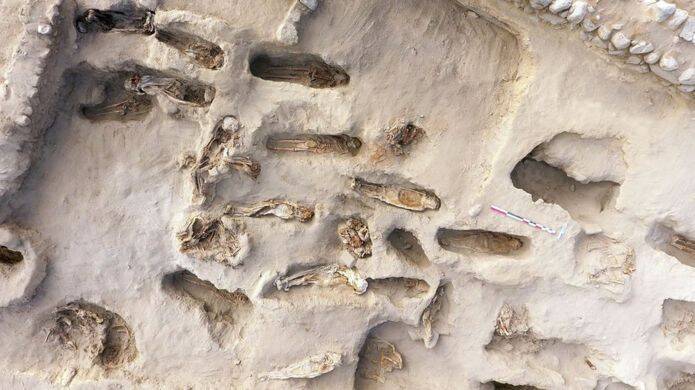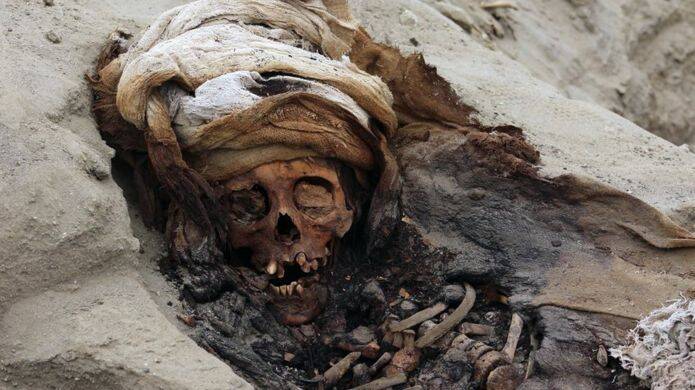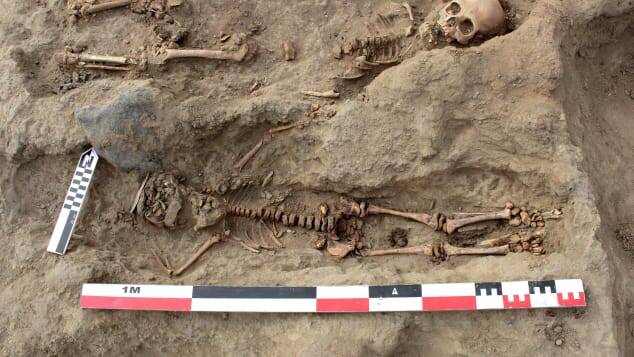Before the Inca conquered the Chimú, the coastal Peruvian civilization built the largest mud-brick city in the world. They also partook in the ritualistic mass sacrifice of children.

AFPResearchers believe the mass sacrifice was a ritualistic offering to the Chimú’s moon god, in order to ward off El Niño-related weather.
Archaeologists in Peru have just discovered what is likely to be the largest mass child sacrifice site in recorded history. The 227 victims were found north of Lima, near the coastal town of Huanchaco. According to the BBC, every single one of them was aged between five and 14.
It’s currently believed that the children were killed more than 500 years ago. The archaeologists said that some of the corpses still had hair and skin, with clear signs indicating that the children were killed during wet weather.
They were also facing the ocean, which suggests they were likely sacrificed as an offering to the gods worshipped by the Chimú people of the region. They were one of the strongest most independent civilizations at the time and established themselves along Peru’s northern coast.

AFPIn 2018, two child sacrifice sites were discovered nearby. 56 bodies were found in June. In April, 140 children — and 200 llamas — were found. This latest site is larger than both of those combined, excluding the llamas.
While it’s uncertain exactly when these children were sacrificed, it’s clear that they died over 500 years ago, and that the Chimú reached the height of their empire between 1200 and 1400 A.D. before the Incas overran them. The latter were soon thereafter conquered by the Spanish.
Nonetheless, according to CNN, it was the Chimú who built Chan Chan — the biggest city in pre-Columbian South America.
To put this discovery into some regional context, it was only last year that researchers unearthed 200 child sacrifice victims of human sacrifice at two other sites in Peru. Clearly, long-lost signs of various ancient civilizations on the South American continent are making themselves more and more apparent over time.
The Chimú’s worshipped Shi, a moon god they believed to be more powerful than the sun. Sacrifices and offerings were standard practices to appease Shi during spiritual rituals, of which these 227 children were likely victims of.
The most stunning part of this record-setting, historical find is that the archaeological dig is far from over. Excavations are ongoing, and researchers at the site are more than confident that the 227 bodies will soon be joined by quite a few more.
“It’s uncontrollable, this thing with the children,” said lead archaeologist Feren Castillo. “Wherever you dig, there’s another one.”
Peruvian state media reports suggest Castillo may already be proven right. Media agency Andina claimed the body count estimate is now as high as 250 and that the remains of 40 warriors were discovered as well.

AFPWhile the current tally is at 227, Peruvian state media agency Andina is reporting as many as 250. Archaeologists on site said excavations are ongoing and more are likely to be found.
Most notable is the fact that this is now the third find of its kind at the Pampa La Cruz archaeological site in Huanchaco. Last year’s discoveries were comprised of 56 bodies found in June and 140 children — and 200 llamas — in April.
This particular one, however, thoroughly distinguishes itself by the sheer numbers involved.
“This is the biggest site where the remains of sacrificed children have been found,” said Castillo.
Chan Chan was once the largest mud-brick city on the planet. The Chimú accomplished some impressive civil engineering feats like irrigating the desert sands of Peru’s coast. Their society was comprised of craftsmen, farmers, and varied in social strata from elites to workmanlike classes.
When Inca emperor Topa Inca Yupanqui and his army invaded the city in 1470, however, the Chimú people met their demise. Unfortunately, it seems their centuries-old city might be following suit in the near future. More than 500 years of rainwater has done quite a bit of damage to the mud-made bricks.

AFPEvery single one of the 227 bodies discovered in Huancheco was aged between five and 14. They were facing the ocean, as a potential element of the sacrificial offering to the Chimú’s moon god, Shi.
Castillo believes that even then, over 500 years ago, the Chimú were attempting to ward off weather detrimental to their survival. These sacrifices discovered centuries later, he believes, were directly related to that struggle — and served as appeasements to their gods in hopes the climate would shift.
“They were sacrificed to appease the El Niño phenomenon, we have found more evidence of rainfall in the findings,” Castillo said, according to The Sun. Most harrowing regarding last year’s discoveries was that many of the children had their hearts ripped out as part of the sacrificial ritual. Cuts to their breastbones and dislocated rib cages were clear indications that brutal theory.
According to National Geographic, while it was clear that the Inca engaged in ritual sacrifice, there hadn’t been evidence of it being done by the Chimú until last year.
“Until now, we had no idea that the Chimú did anything like that,” said John Verano, a biological anthropologist and forensic expert at Tulane University. “It’s the luck of archaeology.”
After learning about the largest mass child sacrifice in history, read about the tragic story of the Jonestown Massacre, modern history’s largest mass “suicide.” Then, learn about archaeologists solving the mystery of unexplained deaths near the “portal to hell.”





